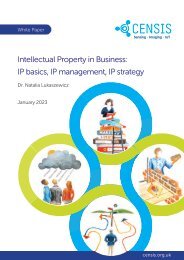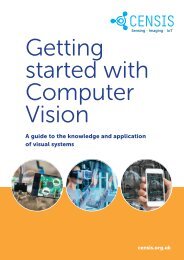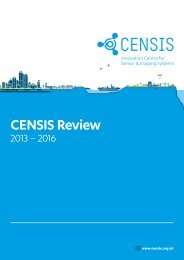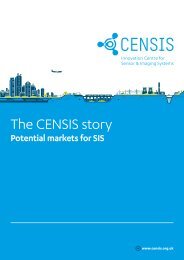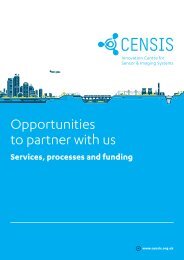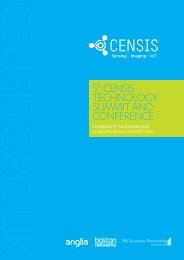Getting started with IoT
IoT is here and it's time for organisations across the country to take advantage of the transformational benefits of the technologies and expertise available. CENSIS explores IoT for business growth in this IoT starter guide. censis.org.uk
IoT is here and it's time for organisations across the country to take advantage of the transformational benefits of the technologies and expertise available. CENSIS explores IoT for business growth in this IoT starter guide. censis.org.uk
You also want an ePaper? Increase the reach of your titles
YUMPU automatically turns print PDFs into web optimized ePapers that Google loves.
1<br />
Sensors<br />
As the ‘data gatherers’, sensors are the starting point of any <strong>IoT</strong><br />
solution. The sensors must measure an accurate representation<br />
of the conditions, otherwise the data is unreliable and unusable.<br />
The better the quality of the data gathered through an <strong>IoT</strong> system,<br />
the better value and insight that will result from the analysis.<br />
A sensor collects information from a defined source and converts<br />
this into a signal that can be measured. The sensor resides at the<br />
edge of the <strong>IoT</strong> system and is often referred to as an ‘edge node’ or<br />
‘end node’.<br />
There’s a vast<br />
range of sensors<br />
already on the market<br />
that can be integrated<br />
into <strong>IoT</strong> systems.<br />
Sensors readily available to measure or detect<br />
• Distance • Gases, vapours, chemicals, pH • Humidity<br />
• Image recognition • Luminosity, radiance • Magnetic & electric fields<br />
• Material stress, strain • Moisture • Motion<br />
• Pressure • Proximity • Shape, colour, pattern, movement<br />
• Sound • Speed, direction, position • Temperature<br />
• Vibration • Wavelengths of light • Multi-axis orientation<br />
Cost<br />
Ease of use<br />
and integration<br />
Reliability<br />
Availability<br />
Factors<br />
to consider<br />
when<br />
choosing<br />
sensors<br />
Accuracy<br />
levels<br />
Range, calibration<br />
and resolution<br />
required<br />
Power<br />
consumption<br />
Environment<br />
Will the sensor get too hot or<br />
cold to function?<br />
Common sensor interfaces<br />
There are many different communication protocols<br />
used to interface a microcontroller <strong>with</strong> sensors.<br />
Unlike the rest of the communication protocols<br />
found in <strong>IoT</strong> applications, these are mostly always<br />
wired. All of the protocols below are commonly<br />
supported by most microcontroller devices.<br />
• UART / Serial<br />
• SPI<br />
• I²S<br />
• GPIO<br />
• I²C<br />
• ADC<br />
• 1-Wire<br />
Always check <strong>with</strong> the sensor manufacturer that the<br />
communication protocols used by the sensor are<br />
supported on the microcontroller.<br />
Sensor<br />
Sensor<br />
Interface<br />
Data Flow<br />
Microcontroller<br />
Sensor<br />
Interface<br />
Communications<br />
Module<br />
14





